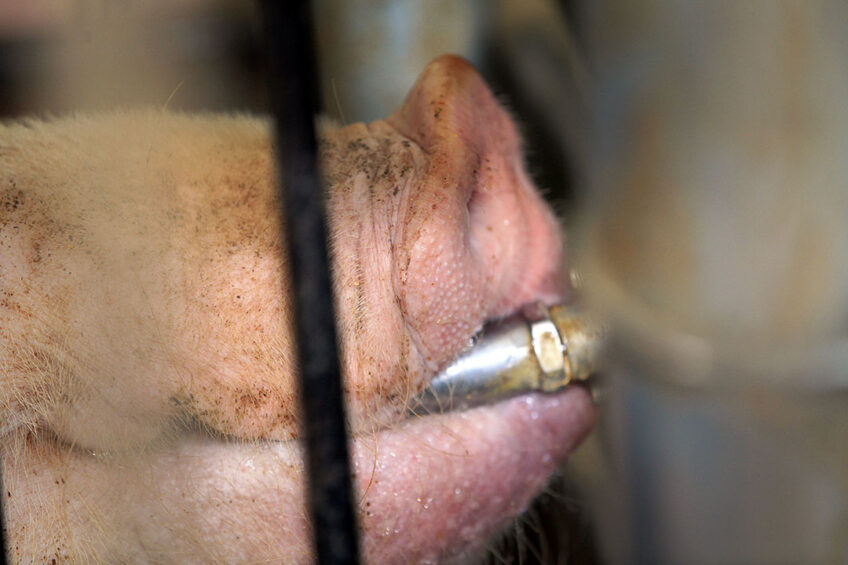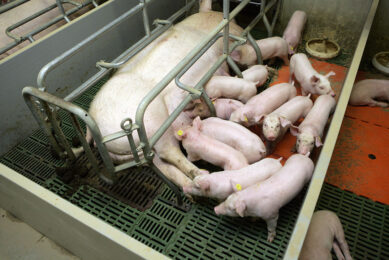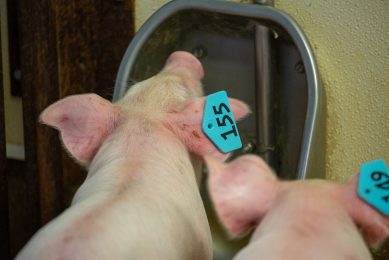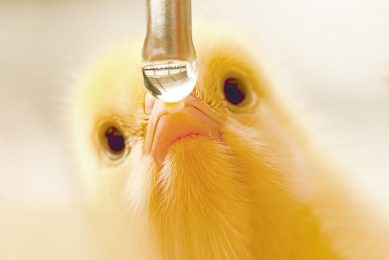Water: the forgotten nutrient in the swine industry

Water is an essential nutrient to the individual pig’s welfare. Although it is inexpensive to provide, water is often the most neglected nutrient. Water comprises approximately 80% of body weight at birth and decreases to 50% in a finished market pig. Withholding water from a pig for longer than 24 hours results in water deprivation or salt poisoning. In addition, losing 10% or more of body water leads to severe dehydration and death. In this article we will discuss water function and quality, water requirements for all stages of pig production, recommended drinker measures, and the water resource location within the home pen.
Water functions
Pigs require water for biochemical reactions, proper function of cells, maintaining body temperature, nutrients transportation into the body tissue, removing metabolic waste, growth, and reproduction. There are 3 major water sources for pigs: (1) water consumed by the individual pig, (2) water as a component of feedstuffs and (3) water obtained via oxidised carbohydrates, fats, and proteins.
Water quality
Maintaining good water quality and easy access are necessary to have healthier pigs and to enhance production effectiveness. Water should appear colorless and odorless. High level of coliform bacteria is an indication of fecal contamination in the water source. Drinking water for pigs should contain fewer than 100 total bacteria per milliliter and fewer than 50 coliforms per milliliter. In addition, it is recommended that good quality drinking water for pigs include total dissolved solids equal or less than 3000 ppm; a pH that ranges between 6.5 and 8.5; the maximum iron limit is 0.5 ppm; nitrate/nitrite level equal to 10 ppm and sulphate at 1000 ppm.
Water requirements
Inadequate water supply can result in overheating, dehydration and even death. Permanent access to drinking water will ensure the physiological needs of individual pigs are always met in a flexible and individualised way. Phase is an important factor affecting water usage by the pig. Nursery pigs (up to 27 kg body weight) require 2-5 Litter/pig/day, grower pigs (27-45 kg body weight) consume 5-12 Litter/pig/day, finisher pigs (45-113 kg body wight) need 7-12 Litter/pig/day, non-pregnant gilts use 12 Litter/pig/day, pregnant sows drink 12-25 Litter/pig/day, lactating sows utilize 10-45 Litter/pig/day, and boars require 12-20 Litter/pig/day.
Positioning drinkers too high restricts water intake for smaller pigs and drinkers positioned too low results in water wastage problems
Recommended drinker measures
The recommended number of pigs per drinker is 1:10 for nursery pigs, 1:12 or 1:15 for grower pigs, finisher pigs, non-pregnant gilts, pregnant sows, and boars, and 1:1 for lactating sows. The suggested drinker flow rate is 0.7-1 Litter/minute for nursery pigs, 1-1.5 Litter/minute for grower pigs, 1.2-1.5 Litter/minute for finisher pigs, and 2 Litter/minute for non-pregnant gilts, pregnant sows, lactating sows, and boars. Positioning drinkers too high restricts water intake for smaller pigs and drinkers positioned too low results in water wastage problems. Appropriate drinker height is 13-30 cm for nursery pigs, 30-46 cm for grower pigs, 46-61 cm for finisher pigs, 61-76 cm for non-pregnant gilts, pregnant sows, and lactating sows, and 76-91 cm for boars.
Drinker location
Proper drinker location and maintenance increase water consumption. Drinkers placed too close to each other or too close to the feeder could result in one or more pigs to dominate the drinker. Drinkers should be in an area free of incoming air to prevent pipe freezing. Leaking drinkers can result in water wastage causing wet lying areas and increased disease incidence. In addition, it is wise to monitor pen dunging areas and avoid water bowl placement in that area.
Conclusion
Researchers consider water as the forgotten nutrient in the swine industry. Pump breakdowns, blockage of water lines and nipple drinkers, and lack of access to enough water at the right temperature will lead to water deprivation. Thus, it is important to ensure that all pigs have easy access to good quality drinking water daily and to fix any issues quickly to avoid water deprivation, salt poisoning and death.











